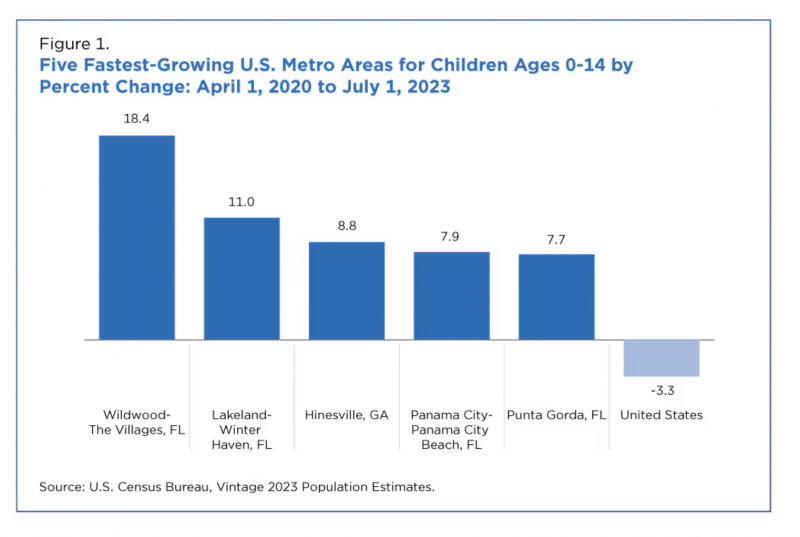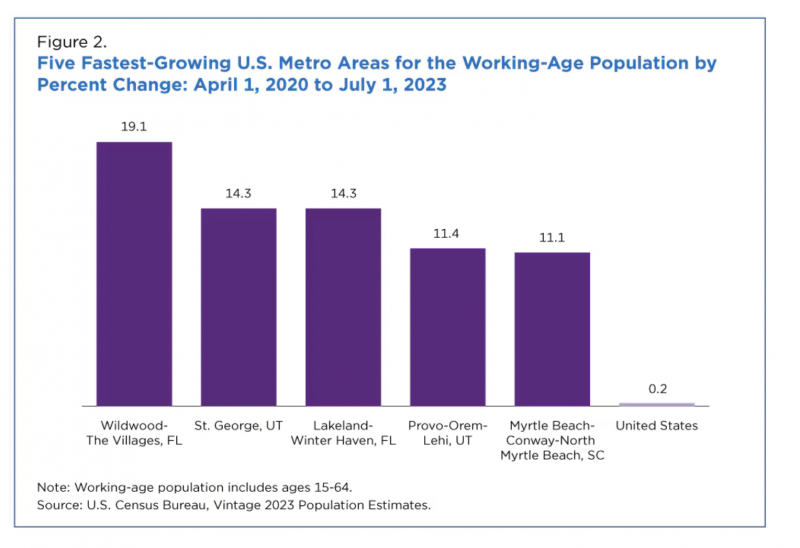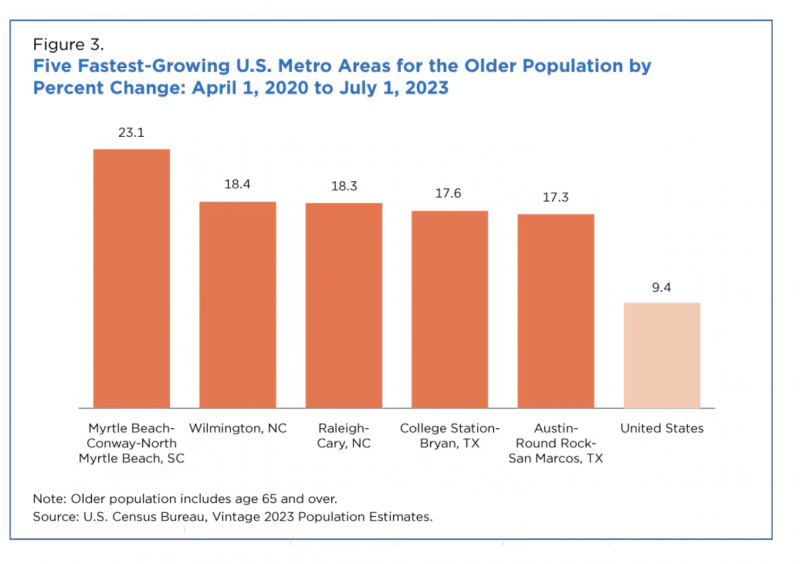The Lakeland-Winter Haven area had the largest numeric gain in the population ages 0-14. Other parts of Florida have the fastest-growing working-age population in the nation.
WASHINGTON – The population age 65 and over increased in all but one (Eagle Pass, TX) of the nation’s 387 metro areas, while the population of children declined in many metro areas from April 1, 2020, to July 1, 2023.
An examination of changes in the age make-up of the population from April 1, 2020 to July 1, 2023 revealed notable growth in the older adult population, particularly when compared to changes in the population of children.
“While some metro areas saw increases in their youth population and many saw gains in working-age populations, what's particularly remarkable is the near-universal increase in the older population for metro areas across the country,” said Lauren Bowers, chief of the Census Bureau’s Population Estimates Branch.
The three age categories featured in the analysis were: 0-14 (children); 15-64 (working age); and 65 and older (older adults).
Children: Ages 0-14
The total number of U.S. children declined by 3.3% nationally, with around 80% (311) of U.S. metro areas, including some of the most populous, experiencing a decrease in the number of children from April 1, 2020, to July 1, 2023.
New York-Newark-Jersey City, NY-NJ, Los Angeles-Long Beach-Anaheim, CA, Chicago-Naperville-Elgin, IL-IN – the nation’s three most populous metro areas in 2023 – had a combined loss of around 614,000 children since 2020, accounting for about 30% of the total U.S. decline in the number of children between 2020 and 2023.
Three California metro areas – San Jose-Sunnyvale-Santa Clara, Santa Cruz-Watsonville, and Napa – had the highest percentage losses of children: 11.8%, 11.1% and 10.7%, respectively.
The child population increased in around one-fifth of metro areas.
Lakeland-Winter Haven in Floridahad the largest numeric gain in the population ages 0-14 (about 14,600) and was among five U.S. metro areas with the fastest-growing children populations. Three other Florida metro areas made the list (Wildwood-The Villages, Panama City-Panama City Beach, and Punta Gorda)and one in Georgia (Hinesville).
Working-Age Population: Ages 15-64
Between 2020 and 2023, the working-age population grew by 0.2% nationally and a majority of U.S. metro areas (about 52%) saw an increase.
Some metro areas even experienced double-digit growth in their working-age population, particularly those in the South (Floridaand South Carolina) and the West (Utah).
The five metro areas with the fastest-growing working-age population were:Wildwood-The Villages, FL (19.1%); St. George, UT (14.3%);Lakeland-Winter Haven, FL (14.3%);Provo-Orem-Lehi, UT (11.4%); and Myrtle Beach-Conway-North Myrtle Beach, SC (11.1%).Punta Gorda, FL (10.3%),andCape Coral-Fort Myers, FL (10%)also grew by at least 10% from 2020 to 2023.
These metro areas experienced growth across all three age categories.
Three Texas metro areas had six-figure gains in the working-age population during the period: Dallas-Fort Worth-Arlington (about 318,000); Houston-Pasadena-The Woodlands (about 224,000); and Austin-Round Rock-San Marcos (about 136,000).
The Dallas-Fort Worth and Houston metro areas added the most working-age residents.
The Phoenix-Mesa-Chandler, AZ, and Atlanta-Sandy Springs-Roswell, GA, metro areas also experienced notable growth in their working-age population: about 155,000 and about 124,000, respectively.
Older Adults: Age 65 and Over
The growth of the 65 and over population from 2020 to 2023 is striking: up 9.4% to approximately 59.2 million nationally. The population of older adults increased in every U.S. metro area except in Eagle Pass, TX, as previously mentioned.
Myrtle Beach-Conway-North Myrtle Beach, SC, the second-fastest growing U.S. metro area in total population between 2020 and 2023, had the fastest-growing population of older adults: up 23.1% to 107,430.
In neighboring North Carolina, both the Wilmington and Raleigh-Cary metro areas saw high growth in their older adult population this decade: up 18.4% in Wilmington and 18.3% in Raleigh.
“Increased longevity and the large baby boomer generation born from 1946 to 1964 are contributing to the growth in the older adult population,” Bowers said. “As that generation continues to age, growth in the older adult population is expected to continue across the nation’s metro areas.”
Kristie Wilder is a demographer and Paul Mackun is a geographer in the Census Bureau’s Population Estimates Branch.
© 2024 Florida Realtors®








